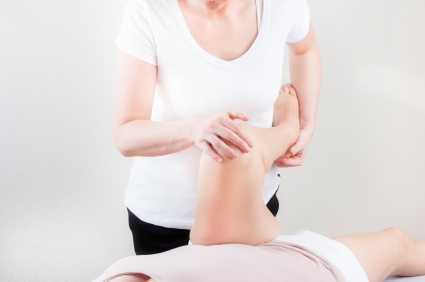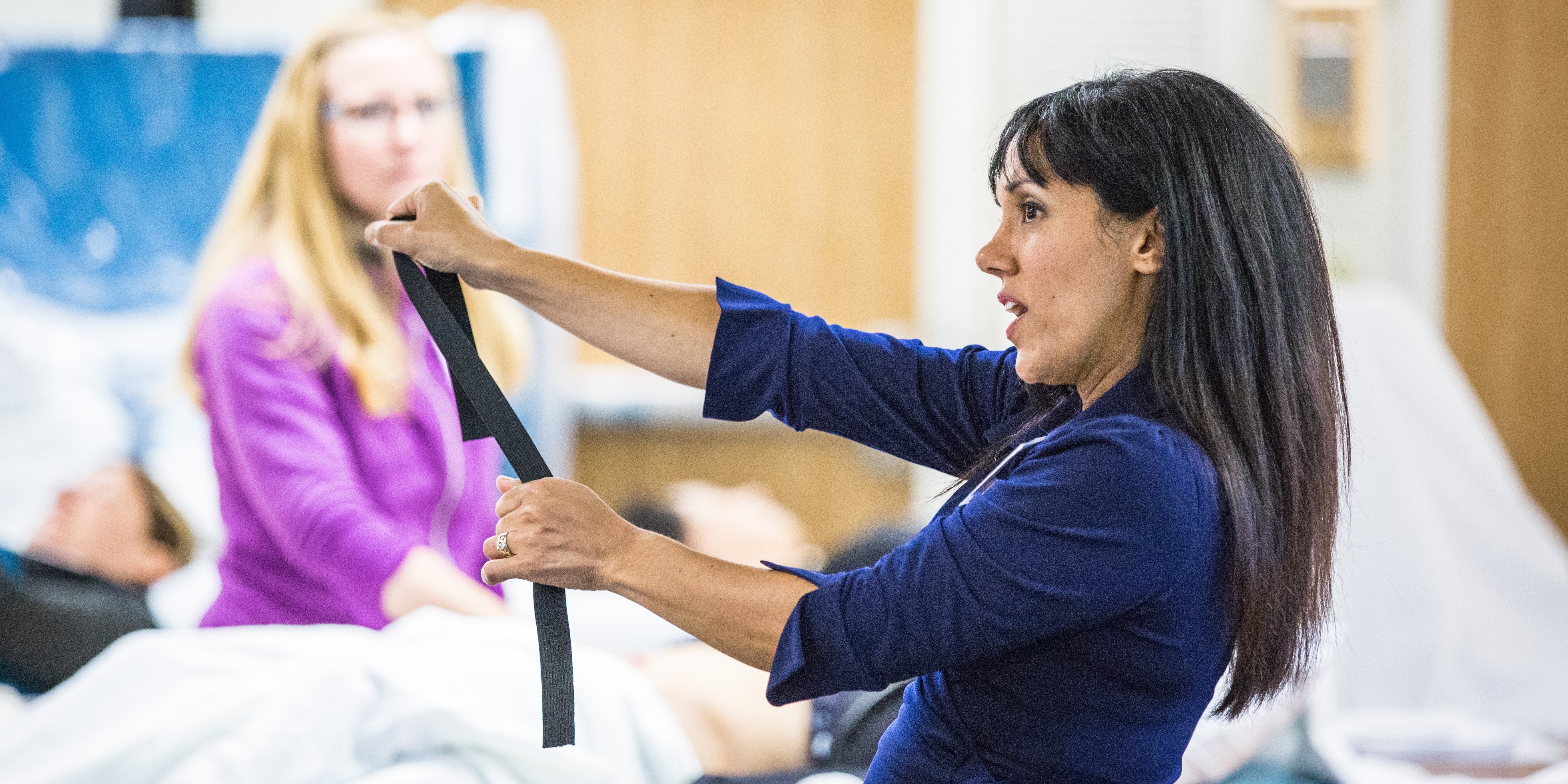This post was written by H&W instructor Ginger Garner. Ginger will be presenting her Hip Labrum Injuries course in Houston in 2015!

One of the easiest ways to determine if someone is in pain is to watch the way they move. And perhaps the most commonly observed and universal movement pattern is gait. From a subtle loss of trunk rotation or pelvic translation to a gross loss of reciprocal gait, a dynamic assessment of walking is a very valuable tool in the physical therapist’s toolbox.
In evaluation of the hip, gait assessment is a critical element of the physical therapy exam. Pain-free ambulation is an essential part of measuring a person’s quality of life (QOL) and is a clinically significant functional outcome measure. Loss of hip extension and knee hyperextension prior to or at heel strike are part of several self-limiting patterns that arise from intra-articular hip injury. Dynamic gait assessment can give the therapist distinct clues as to hip pathophysiology etiology.
It was previously assumed that surgery to correct intra-articular pathology, such as in CAM-based femoracetabular impingement (FAI), would result in correction of deficiencies in gait patterning. CAM FAI limits and creates pain in the direction of hip osteokinematic flexion, adduction, and internal rotation range of motion and is caused by a lack of sphericity of the femoral head and neck, causing impingement of the labrum and/or chondral contact at the acetabulum.
A recent study published in 2013 in Gait and Posture, shows that previous assumptions about gait are incorrect. The study compared the gait of healthy controls to those with FAI and hypothesized that gait abnormalities would resolve status post surgery.
Gait measures were obtained both preoperatively and postoperatively. Researchers were surprised to find that gait abnormalities found presurgically did not automatically resolve postsurgically. Another pertinent finding is that the surgical patients not only retained their old faulty antalgic gait patterns and habits, they also adopted new abnormalities that resulted from surgical intervention, such as those arising from scar tissue, soft tissue pathology, neuromuscular patterning, or loss of arthrokinematic motion in the hip. These findings underscores the importance of early intervention via physical therapy for both operative and nonoperative patients if we want our patients to enjoy or return to a high quality of life.
Although the patients in the study who underwent FAI surgery did demonstrate decreased pain, nonoptimal preoperative gait patterns that persist postoperatively can put these patients at risk for reinjury (e.g. labral retears) or related cobmorbidities like pelvic pain, back pain, or sacroiliac joint dysfunction.
Further, a separate study published in 2009 established the presence of altered hip and pelvic biomechanics during gait, finding that those with hip FAI had decreased peak hip abduction, attenuated pelvic frontal ROM or translation, and less sagittal ROM than controls. Soft tissue restriction including scar tissue from previous or current surgeries, myofascial restriction, or neuromuscular patterning problems are, again, all important variables which must be differentially diagnosed for their possible contribution to the loss of ROM and function. Other considerations that can alter gait pattern and increase injury or reinjury risk assessment of capsular mobility, ligamentous integrity, and sacroiliac joint contributions to limited hip ROM and excursion.
To learn more about nonoperative and operative hip labral and FAI management, check out faculty member Ginger Garner's continuing education course on Extra-Articular Pelvic and Hip Labrum Injury: Differential Diagnosis and Integrative Management. The next opportunity to take the course is March of 2015 in Houston.

Research published last year in Archives of Gynecology and Obstetrics describes the benefits of "triple therapy" for symptoms of urogenital aging in postmenopausal women. The triple therapy included pelvic floor rehabilitation, intravaginal estradiol, and Lactobacillus acidophili on symptoms of urogenital atrophy, urinary tract infections (UTI's), and stress urinary incontinence (SUI) in postmenopausal women. 136 women with postmenopausal urogenital aging symptoms were divided into two groups of 68 women. Group 1 received intravaginal treatment of combined estriol (30 mcg) and Lactobacillus acidophili (50 mg) and pelvic floor rehabilitation. Group 2 received intravaginal estriol (1 mg) plus pelvic floor rehabilitation. The intravaginal treatment was applied once/day for 2 weeks and then twice/week up to 6 months.
Symptoms of urogenital aging listed by the authors include lower urinary tract issues (urinary frequency and urgency, nocturne, dysuria, recurrent UTI's, and urinary incontinence (UI)), and vaginal or vulval symptoms (vaginal dryness, itching, burning, and dyspareunia.) The connection between the microbiota Lactobacillus acidophili and vaginal health is described in the article involves the proliferation of Lactobacillus acidophili that is stimulated by estrogen. The microbiota then is reproduced in the vaginal epithelium, reduces pH, and prevents colonization of pathogens that can lead to UTI's. The pelvic floor muscle training was completed "…as explained by Castro et al…" in reference to the 2008 study assessing the efficacy of pelvic floor muscle training, vaginal cones, electrical stimulation, and no active treatment. The pelvic floor training in the Castro study included group sessions of pelvic floor muscle contractions as follows: 10 repetitions of 5 seconds contract, 5 seconds relax; 20 repetitions of 2 seconds contract, 2 seconds relax; 20 repetitions of 1 second contract, 1 second relax; 5 repetitions of 10 seconds contract, 10 seconds relax; and 5 simulated cough with strong contraction with 1 minute rest in between.
In the study, the authors assessed outcomes of urogenital symptoms in women aged 55-70 including urine cultures, colposcopic and urethral cytologic findings, urethral pressure profiles, and urethro-cystometry before and 6 months after intervention. Results included that both groups demonstrated significant improvements in symptoms and signs of urogenital atrophy , and 76% of the triple therapy group (Group 1) reported improvement in incontinence versus 41% of Group 2. Subjects in the triple therapy group also were observed to have significant improvements in colposcopic findings, urethral pressure and closure, and in abdominal pressure transmission ratio to the proximal urethra. The study concludes that combination therapy of estriol, Lactobacillus acidophili, and pelvic floor rehabilitation should be considered first-line treatment for postmenopausal symptoms of urogenital aging. To learn more about menopausal evaluation and interventions, check out faculty member Michelle Lyons' new course on Menopause: A Rehabilitation Approach. The next opportunity to take this course is in February in Orlando.
Visceral therapy is used by manual therapists, and research continues to emerge that attempts to explain the underlying mechanisms of the techniques. A study published in the Journal of Bodywork & Movement Therapies in 2012 reports on the effects of visceral therapy on pressure pain thresholds. Osteopathic visceral mobilization was applied to the sigmoid colon in 15 asymptomatic subjects. Pressure pain thresholds were measured at the L1 paraspinal muscles and 1st dorsal interossei before and after intervention. Pressure pain thresholds at the level assessed improved significantly immediately following the visceral mobilization. The effect was not found to be systemic. Hypoalgesia, therefore, may be a mechanism by which visceral mobilization affects patients who are treated with this technique.
Another research study that aimed to assess the effects of visceral manipulation (VM) on low back pain found that the addition of VM to a standard physical therapy treatment approach did not provide short term benefits. However, when the 64 patients were reassessed at 2, 6, and 52 weeks following treatment, the patients in the group with visceral manipulation were found to have less pain at 52 weeks. The patients were randomized into 2 equal groups and were provided physical therapy plus a placebo visceral treatment or a visceral treatment in addition to physical therapy. The authors propose that there may be long-term benefits of including visceral therapy in rehabilitation approaches.
If you would like to learn more about visceral techniques as well as theory and clinical application, check out the updated schedules for Ramona Horton's Visceral Mobilization 1 (VM1): The Urologic System, and Visceral Mobilization 2 (VM2): The Reproductive System. The first opportunity to take VM1 is in January in New Jersey and VM2 is scheduled in September in Ohio.

Women who are diagnosed with and treated for breast cancer commonly suffer from decreased function and fitness, and may be at risk for increased rates of functional decline than women not treated for cancer. This topic is highlighted in a paper published earlier this year in the International Journal of Physical Medicine & Rehabilitation. The authors of this article acknowledge that exercise during and following treatment for breast cancer has significant positive health effects including physical and psychosocial benefits. Cardiorespiratory and resistance training are often recommended to patients as modes of exercise that a breast cancer survivor should participate in, yet the authors raise the question about safety of the recommended exercise programs.
A literature review was completed and in this study 73 studies were included. The studies described exercise programs for patients with breast cancer during treatment and following treatment. The exercise programs within the studies varied widely, with aerobic exercise being prescribed from 10-60 minutes/session, 20-300 minutes/week, at light to vigorous intensity, and with a frequency of 1-7 days/week. The resistance-based exercises, although based on standard exercise principles, also varied dramatically in instructed parameters, according to the authors.
Other key information the authors report from the literature review is that many of the research studies were not representative of the typical patient diagnosed with breast cancer. In fact, as is described in this open-access article, women in the studies were usually younger, had less advanced disease, and in general were more well than the typical patient. For example, listed exclusion criteria in many of the studies included cardiovascular disease, diabetes, COPD, and stroke- some of the most common conditions that a woman with breast cancer also reports.
The take-home point of the article is that because many of the subjects in the exercise studies were not representative of the typical patient with breast cancer, the exercise recommendations may not be appropriate for generalization to most patients during or following treatment for breast cancer. The authors recommend future research considerations that include finding out why women choose to participate in exercise trials or choose to exercise on their own. With so many women simply being given general exercise instructions, the issue of supervised versus unsupervised exercise training, especially for women with more advanced illness should be considered.
If you would like to add more knowledge and skills to your toolbox for treating women diagnosed with breast cancer, you can join faculty member Susannah Haarmann's course Rehabilitation for the Breast Cancer Patient. In 2015 this course is currently scheduled in February in Arizona and in June in Illinois. We hope that you can join us for this specialty course!

If your experience of learning sacroiliac joint mechanics, testing, and treatment has been confusing at times, trust that you are not alone in this confusion. As students have emerged from training and coursework using a variety of models to understand the joint and surrounding structures, no wonder there is disagreement and inconsistency in clinical application of learned skills. Add to this the many names for a maneuver such as the one leg standing test, and we see that the more we can streamline updated clinical knowledge and practices, the better for our profession and for our patients. I recently enjoyed reading an article summarizing assessment and treatment of sacroiliac joint (SIJ) mechanical dysfunction by Dr. Manuel Cusi, who completed a PhD thesis regarding the joint. In the article, Dr. Cusi summarized a great deal of research-based concepts related to testing and treating this issue.
Although the structure and purpose of the sacroiliac joint are described as "controversial", the author points out the foundational concept that too much or too little stability within the SIJ can create dysfunction. The "self-bracing" mechanism is provided in the pelvic girdle via both form and force closure, and Dr. Cusi points out that this joint stability that is the aim of the self-bracing mechanism must be responsive to each specific loading condition, as a function of gravity, and with coordination of muscle and ligament forces. Also according to the article, in order to assess the SIJ, the focus must be on function rather than solely on anatomic pathology.
Mechanical testing is described as being generally divided into pain provocation or palpation tests. Although we can say, based on the literature, that no one SIJ test can provide reliable data, a cluster of several tests that are positive can provide meaningful information towards a diagnosis. In order to test various aspects of SIJ function, the following tests are listed in the paradigm model. A working knowledge of the tests below, as well as pelvic joint stability tests should comprise the clinician's "toolbox" of tests for the sacroiliac joint, and this is in addition to skills used for determining other causes of SIJ pain such as disease processes or referred symptoms.
•Posterior pelvic pain provocation test (or thigh thrust)
•Long dorsal sacral ligament palpation
•Trendelenburg test
•Stork test (or Gillet test)
•Active straight leg raise (ASLR)
•Patrick's FABER and Gaenslen's test
In relation to treatment approaches, exercise training is recommended as being divided into three stages: isolation (recruiting targeted muscle in isolation of other groups), combination (muscles are recruited in various combinations to develop endurance), and function (utilizing good technique once progressed to meaningful functional tasks). While this flow of exercise training may appear very logical, the author offers that failure to progress through these three phases may be due to several factors such as poorly designed exercises that lack specificity, progressing through exercises before patient has sufficient endurance, poor adherence, and lack of appropriate exercise technique. These factors are described in the article as intrinsic to the exercise program, whereas an extrinsic factor may be failure of the exercise program to work well because of poor ligamentous stability. In this case, the author further describes the therapeutic option of prolotherapy, which will be discussed in an upcoming post.
If you are interested in learning more about the above special tests or about treatment progressions based on technique and integration, check out Peter Philip's Sacroiliac Joint and Pelvic Ring Evaluation & Treatment. The next opportunity to take the course is in January in Seattle.
Last week, Evidence in Motion, a large continuing education company that offers both live and online courses, announced that they are offering a new certificate program on pelvic rehab.
The Pelvic Health Certificate (PHC) includes a number of courses on male and female pelvic health.
At Herman & Wallace, we think it's wonderful to see yet another example of pelvic rehab being offered and promoted as part of "mainstream" physical therapy practice, particularly by an organization that has previously focused on orthopedics, manual therapy and sports medicine. The increased number of continuing education offerings on the topics of pelvic floor dysfuntion in men and women means that all the hard work our amazing faculty, course participants and certifed therapists have done over the years has finally brought pelvic rehab into the limelight!
Just like H&W, Evidence in Motion's program shys away from using "women's health" to stress that these courses cover pelvic dysfunction in men and women throughout the life cycle. While we are taking some issue with their contention "Sadly, once you are finished with school, you’ll be hard pressed to find a continuing education course that mentions the pelvic floor unless you find a course with “women’s health” in the title" (AHEM! Over here! Check out our incredible course offerings and our amazing and inspiring Certified Pelvic Rehabilitaton Practitioners!) we think it's wonderful to see yet another organization trying to get the word out to therapists, patients and referral sources about the incredible work our therapists do!
Consider the significant numbers of patients who suffer from post traumatic stress disorder, or PTSD. In the pelvic rehabilitation setting, we can think of the patients who may have experienced abuse, a loss of a child, witnessing violence, or other potential precursor. We know from the literature that there is a correlation between traumatic events such as abuse and women who have pelvic pain, within the military population, and among women who experience birth trauma. How then, can we provide patients with self-management tools to address common challenges that accompany PTSD?
Research published online this month in the journal "Mindfulness" states that in patients exposed to trauma, "…those with relatively high levels of mindfulness skills tend to have lower levels of symptoms. The article highlights previous research that has described benefits of mindfulness skills as including decreased anxiety and depression. Mindfulness-based interventions, according to the article, focuses on the development of the skills of awareness (the ability to focus on the here and now, aware of both inner and outer experiences) and acceptance (having a curious, nonjudgmental and open attitude.)
In this study, 101 patients diagnosed by a psychiatrist or psychologist with PTSD completed questionnaires including the Mini-International Neuropsychiatric Interview. The authors found skills in mindfulness correlated negatively with severity of symptoms and with "reactivity" or a tendency to respond with anxiety or depressive thoughts in response to stress. These positive relationships between mindfulness skills and symptoms of PTSD may have a significant impact on many of our patients who suffer from a variety of dysfunctions impacting health.
There is still time to sign up for Carolyn McManus's practical course on mindfulness training. Keep in mind that all therapists (not just pelvic rehab providers) will find this course immediately applicable to their caseload. Join us this November in Seattle for our new offering: Mindfulness-Based Biopsychosocial Approach to Chronic Pain.

What are the roles of hip labrum innervation in both nociception and proprioception? Canadian researchers tackled this question by studying hip joints that were harvested during total hip replacement or hip resurfacing surgery. Twenty labrums were harvested and the structures in the labrum were divided into four quadrants including antero-superior (AS), postero-superior (PS), antero-inferior (AI), and postero-inferior (PI). The mean age of the subjects was near 60. The authors reported the following:
•Labral innervation is from a branch of the nerve to the quadratus femoris and the obturator nerve.
•All labrum samples had abundant free nerve endings according to the authors. These nerve endings are responsible for nociception transmission.
•Three different types of nerve end organs were noted: Vater-Pacini, Golgi-Mazonian, and Ruffini corpuscles. These nerve end organs operate to provide proprioception through their roles in pressure, deep sensation, and temperature.
•The free nerve endings and nerve end organs were observed more often in the AS and PS zones.
•The nerve endings were noted to be abundant in the superficial zones of the acetabular labrum which were for the most part avascular.
•The antero-superior zone of the labrum has abundant free nerve endings, a fact that correlates with the location of common labral tears and that also fits with the pain produced using a maneuver to test impingement in the hip (flexion, adduction, internal rotation).
•No significant differences in age was noted with respect to the innervation.
The study further states that a labral debridement may ease pain with removal of the free nerve endings, yet the labral repair may best allow for proprioceptive abilities and higher function in the injured hip. The authors also describe the findings that there are abundant myofibroblasts in the labrum that may account for the labrum's ability to heal. To learn more about healing labrums and getting patients moving, check out faculty member Ginger Garner's continuing education course on Extra-Articular Pelvic and Hip Labrum Injury: Differential Diagnosis and Integrative Management. The next opportunity to take the course is in March in Houston.
How long do hot flashes last in a woman's life? One recent study asked this question by following 255 women from premenopause to natural menopause. The authors found that moderate to severe symptoms of hot flashes continued on average 5 years after the date of the woman's last period. Unfortunately, up to 1/3 of the women continued to report hot flashes 10 or more years after menopause. Results also found that risks for hot flashes were higher in women who were African-American or in obese, white women. Higher education level was found to be protective against hot flashes.
The Mayo clinic states that while the exact cause of hot flashes is not known, there are several factors that may influence their occurrence. Changes in reproductive hormones in addition to hypothalamic shifts create a sensitivity to even slight changes in temperature. Women can experience a wide range of menopausal symptoms, with hot flashes ranging from sudden feelings of warmth that occur a couple times per day to profuse sweating that can occur up to one time per hour.
Menopause.org is a helpful resource for our patients, and lifestyle changes are offered such as avoiding stress, breathing techniques, and creating strategies to maintain body temperature within a limited range. Hormonal treatment and non-hormonal options are also described on this site, and while certain hormonal options may be contraindicated for some patients, there are therapies such as sleeping medications that may improve quality of life for a woman who is suffering significant sleep disruption. Decisions to utilize hormonal drug therapy may depend on many factors, such as benefits to risk ratios, if the patient has her uterus, and age of the patient. Many nonprescription options are also available, with conflicting or little evidence to support many of the claims. Regardless of the remedy that a patient may take for her menopausal symptoms, keep in mind that all medications or supplements should be reported to the physician and/or pharmacist so that drug interactions can be screened. Even herbal supplements can have a negative impact on other drugs that a woman is taking, so she should always fully disclose her medications, supplements (including teas!), creams, and other natural remedies.
If you are working with more women in the perimenopausal period, you may have questions about the hormonal changes and effects on rehabilitation. Faculty member Michelle Lyons will offer her new continuing education course called Menopause: A Rehabilitation Approach. At this course she will systemic changes in menopause, bone health, perimenopausal pelvic floor issues, sexual health, weight management, and procedures such as hysterectomy. The next opportunity to take this course is in February in Orlando - what a great time to head to the sunshine!
This November, Herman & Wallace is thrilled to be offering a brand-new course instructed by Carolyn McManus, PT, MS, MA, called Mindfulness-Based Biopsychosocial Approach to Chronic Pain. This course will be offered November 15-16, 2014 in Seattle, WA. We sat down with Carolyn to learn more about her course.

The constant flood of information in today’s interconnected, wired world trains the mind in distraction and away from the immediate experience of life. Many people spend hours gazing down at quickly changing images on the small frame of an electronic device and only notice the body when it has its aches and pains! Mindful awareness offers us a skillful way to pay attention, build body awareness, touch life fully and provides a healing antidote to information overload.
Mindful awareness invites us to rest the mind in the present moment with openness, friendliness and curiosity. This is not our natural tendency and requires training. Often we are caught in a struggle with the present moment, perceive it as flawed, find fault with ourselves and constantly drive ourselves to run, do and achieve. When mindful, we still have our plans, goals and to-do list, but this is not an obstacle to resting the mind here and now. We can stop the struggle with the present moment, touch life fully and open to the potential for ease and insight in the midst of things just as they are. New perceptions and an experience of aliveness can occur that can never happen when we are lost in distraction. Danna Faulds expresses this beautifully in her poem "Walk Slowly":
It only takes a reminder to breathe,
a moment to be still, and just like that,
something in me settles, softens, makes
space for imperfection. The harsh voice
of judgment drops to a whisper and I
remember again that life isn’t a relay
race; that we all will cross the finish
fine; that waking up to life is what we
were born for. As many times as I forget to catch myself charging forward
without even knowing where I am going,
that many times I can make the choice
to stop, to breathe, and be, and walk
slowly into the mystery.
I began practicing mindfulness meditation to help manage stress and heal from a back injury. I found the practice easily translated to patient care and helped my patients build body awareness, detach from maladaptive thinking habits and experience inner calm and relaxation. They gained insight into the reactions, behaviors and situations that escalated and de-escalated their symptoms. Research shows that mindfulness improves attention regulation and executive function, body awareness and emotional regulation. (1) I am excited to share with my colleagues what I have learned through the practice of mindfulness and its applications to both self-care and patient care in my November course.
Learn more about Carolyn's course and join her this November in Seattle to attend her Mindfulness course!
1. Holzel BK, Lazar SW, Guard T, et al. How Does Mindfulness Meditation Work? Proposing Mechanisms of Action From a Conceptual and Neural Perspective. Perspect Psychol Science. 2011;6: 537–559.
By accepting you will be accessing a service provided by a third-party external to https://hermanwallace.com./











































